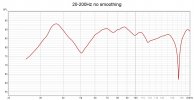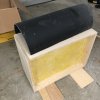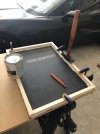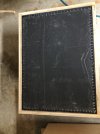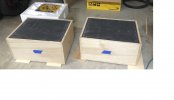Hello everyone
Now I'm more inclined towards making some diaphragmal LF absorbers with limp membranes.
But there are few questions that still unclear.
1) Can I trust to http://www.acousticmodelling.com/multi.php
and
if yes - which porous model is most realistic below 200 Hz ?
Just for explanation why am I asking this
Typical LMBT calc for damped inner volume uses just adiabatic/isothermal approximation
F = K/SQRT(MxD), where either
K=600 (adiabatic) for Tim Farrant formula ( https://www.gearslutz.com/board/bas...etc/743040-tims-limp-mass-bass-absorbers.html ),
K=500 (isothermal) for LFCA with damped light plywood panel membrane ( https://www.acoustic.ua/recommendations/567#4 )
And if we assume different damping in aforementioned calculator, it guves us slightly different results between those adiabatic and isothermal F with different width of central peak.
2) How damping factor can be considered in real world efficiency?
I mean, too heavy (thick and flow resistant) damping will make air spring loose, changing tuning frequency
and
also if total flow resistivity is too high, single short burst will not "pump through" rockwool and calculated efficiency will be available only with stationary resonance signal even if membrane is light and loose.
So, in graph high damping >2 looks nice (wideband and around 0,85 AC on peak) but if it's OK in real construction?
3) Which % of wall coverage will make effective modal disappearance?
I think it might be at least 25% if I imagine ideal tuned absorber like "hole in the wall" for central frequency.
If that matters, there are another current circumstances and thoughts about this
1) I agree with Tim Farrant's idea of combining differently tuned absorbers in room corners and on walls closer to corners. Because some of those frequiencies are close, if I use relatively wideband (= low Q) absorbers, I'll make i.e. "corner stack" working for few modes simultaneously with different efficiency.
2) I have around 30 cm gap between raw walls and frame for inner shell, so all absorbers must fit into this gap. With membranes 5 and 7 kg/sq.m it's acheivable with heavy damping by fluffy rockwool.
3) I understand that all our calcualtions, modal modelling and measurements are not very precise, so I have another one reason to make absorbers with low Q, otherwise with all possible errors I can just miss with all frequencies. When you have ~ 15 Hz width at 0,8 efficiency, it's much safer.
4) raw walls are made from aerated concrete, so I may presume it's surface mass might be around 60 Kg/sq.m, so it's not infinite as start equation means, but sufficiently heavier than membrane. Also, corners are more rigid due to construction.
Because my calculations lead me to not very cheap and easy construction, especially in terms of labour (around 50 pc of ~30x40x60 cm boxes) I'd like to get some feedback from experienced people especially with success stories of bass trapping.
I think it will be useful for any audio enthusiast without personal concert hall.
Now I'm more inclined towards making some diaphragmal LF absorbers with limp membranes.
But there are few questions that still unclear.
1) Can I trust to http://www.acousticmodelling.com/multi.php
and
if yes - which porous model is most realistic below 200 Hz ?
Just for explanation why am I asking this
Typical LMBT calc for damped inner volume uses just adiabatic/isothermal approximation
F = K/SQRT(MxD), where either
K=600 (adiabatic) for Tim Farrant formula ( https://www.gearslutz.com/board/bas...etc/743040-tims-limp-mass-bass-absorbers.html ),
K=500 (isothermal) for LFCA with damped light plywood panel membrane ( https://www.acoustic.ua/recommendations/567#4 )
And if we assume different damping in aforementioned calculator, it guves us slightly different results between those adiabatic and isothermal F with different width of central peak.
2) How damping factor can be considered in real world efficiency?
I mean, too heavy (thick and flow resistant) damping will make air spring loose, changing tuning frequency
and
also if total flow resistivity is too high, single short burst will not "pump through" rockwool and calculated efficiency will be available only with stationary resonance signal even if membrane is light and loose.
So, in graph high damping >2 looks nice (wideband and around 0,85 AC on peak) but if it's OK in real construction?
3) Which % of wall coverage will make effective modal disappearance?
I think it might be at least 25% if I imagine ideal tuned absorber like "hole in the wall" for central frequency.
If that matters, there are another current circumstances and thoughts about this
1) I agree with Tim Farrant's idea of combining differently tuned absorbers in room corners and on walls closer to corners. Because some of those frequiencies are close, if I use relatively wideband (= low Q) absorbers, I'll make i.e. "corner stack" working for few modes simultaneously with different efficiency.
2) I have around 30 cm gap between raw walls and frame for inner shell, so all absorbers must fit into this gap. With membranes 5 and 7 kg/sq.m it's acheivable with heavy damping by fluffy rockwool.
3) I understand that all our calcualtions, modal modelling and measurements are not very precise, so I have another one reason to make absorbers with low Q, otherwise with all possible errors I can just miss with all frequencies. When you have ~ 15 Hz width at 0,8 efficiency, it's much safer.
4) raw walls are made from aerated concrete, so I may presume it's surface mass might be around 60 Kg/sq.m, so it's not infinite as start equation means, but sufficiently heavier than membrane. Also, corners are more rigid due to construction.
Because my calculations lead me to not very cheap and easy construction, especially in terms of labour (around 50 pc of ~30x40x60 cm boxes) I'd like to get some feedback from experienced people especially with success stories of bass trapping.
I think it will be useful for any audio enthusiast without personal concert hall.

